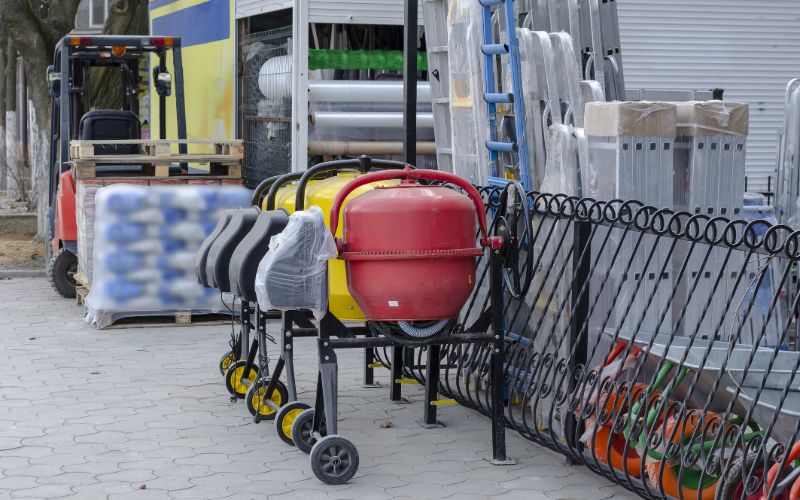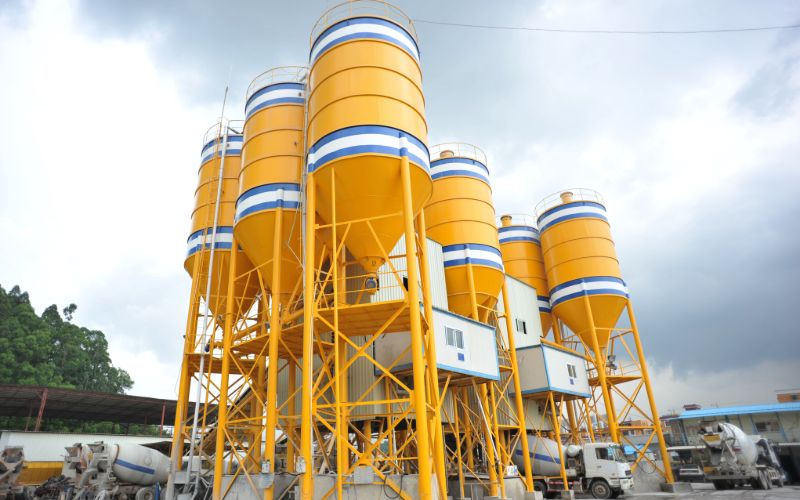In the construction industry concrete mixers otherwise known as cement mixers are an integral tool in performing any structural or day to day operations. These machines blend cement and aggregates like sand or gravel with water in order to produce concrete. Concrete is used as a foundational building material for numerous building structures such as pavements, general residential housing and other integral aspects of infrastructure.
As such, the efficiency and overall quality of the concrete mixer has a direct impact on the durability and longevity of the resulting concrete making the selection of concrete mixer imperative to the structural integrity of the specific project.
The following article will provide a comprehensive overview in order to better understand concrete mixers. This includes the different types of concrete mixers, which mixers BS Power has available and how to best utilise them for a particular project, the possible environmental impact, and safety tips on how to best operate them.
A Little History About Concrete Mixers
The inception of the concrete mixer is certainly not a new one as it dates back to ancient times when masonries were tasked with manually mixing sand, stone and water with wooden paddles and shovels. However, with the rapid expansion of civilization and population growth – more construction was needed and a more efficient means of mixing concrete materials was required.
The first patented concrete mixer was first introduced in the 1900s which allowed builders to produce far more uniform mixtures of concrete which greatly improved construction efficiency. By the mid-20th century, the motorized mixer came to the fore which boasted numerous industrial advancements such as the replacement of hand-cranked models.
Further, drum mixers and truck-mounted mixers become a standardised asset for large construction projects. In the present day we have smart automated mixers which feature advanced feature automation such as GPS tracking and electronic batching controls which optimises efficiency and reduces product wastage.
How Concrete Mixers Work
In order to select the correct model of concrete mixer for a project does require a degree of mechanical understanding which is utilised in the creation of cement.
Loading Of Materials
The first step in making cement involves the loading of materials. This requires cement, sand, gravel and water being added to the mixer. High-end mixers use precise weighing systems to ensure the ideal ratio of each.
Mixing Process
The second step is the mixing process. Through the rotations of the drum or paddles, the key materials are blended together so that an even distribution and proper hydration of the cement occurs.
Discharging
Lastly, is the discharging or pouring out of the concrete. Once the cement is sufficiently mixed, the concrete is then poured through a discharge chute or the opening of the cement drum. In more advanced models of mixers there is the possibility for adjustable pouring and speed control for the concrete’s flow.
The Different Types
Concrete mixers are chiefly categorised according to their design, capacity and how they operate. To better select the correct mixer for your next project – understanding these classifications will allow you to make a well-informed decision about which is best up to the task.
Drum Mixer
The most common type of mixer is the drum mixer. These feature a rotating drum which mixes the various components to the desired consistency. This kind of mixer is preferred for small and medium sized projects where they are valued for their efficiency. An example of this can be found with the 360L Concrete Mixer with Baumax Engine which is specifically designed for use by contractors and rental companies.
Continuous Mixers
Continuous mixers are used specifically for large-scale projects which require a constant supply of concrete. As the name suggests, these mixers continuously feed materials into the machine which provides an uninterrupted flow of concrete. For large-scale and extensive construction operations, this constant supply is a necessity.
Pan Mixers
For a mixer which produces high-quality concrete for precast concrete production – the pan mixer is the machine of choice. This mixer consists of a cylindrical pan with blades or paddles which are responsible for mixing the concrete and ensures a uniform mix.
Self-Loading Mixers
Alternatively, for a mixer which performs the function of loading, mixing, transporting and pouring concrete, the self-loading mixer would be the ideal candidate. These mixers are preferred in remote areas or sites which contain limited infrastructure as they minimise the need for extensive equipment or extra labour.

Modern Concrete Mixers and Advanced Technologies
In recent years, technological advancements have greatly improved the overall performance and efficiency of concrete mixers. The following section will outline some of these recent advancements.
Many of the modern mixers now come fully equipped with GPS tracking and batching control systems which enhance precision and reduce material waste through GPS and automated controls.
Additionally, smart sensors are mounted which track the moisture levels in the concrete to optimise the dry-to-wet material ratios for the highest quality mixes. Lastly, modern cement mixers are also optimised to be energy-efficient designs so that they consume less fuel and electricity. This makes them environmentally friendly and more budget friendly.
What BS Power Has To Offer
No matter what your construction needs, BS Power has a wide range of concrete mixers which can be tailored to your specification.
The 350L Concrete Mixer with a Baumax Engine is the ideal fit for those who are looking to rent this kind of equipment for their own construction needs. Ensuring operator safety with a ring gear cover and enclosed engine cabin, the machine is powered via a steady Baumax RX200 engine which guarantees durability and efficiency.
A slightly larger 400L mixer is designed for rental companies and owners who are conducting medium to large scale projects. This mixer has a reinforced drum and a high-performance engine providing consistent concrete mixing. As a result of its enclosed engine design, the machinery is minimally exposed to dust and debris which guarantees a longer lifespan. This coupled with the heavy-duty chassis means that the mixer is stable and easily moveable across worksites.
The 500L machine is best suited to large projects with a massive drum volume and a robust casing designed to withstand the demands of large-scale operations. Equipped with a high-power Baumax engine, this mixer is a premium mixing option that can deliver superior mixing performance for larger volumes of concrete. Additional safety features are included and an enclosed engine cabin and reinforced drum which guarantees increased durability and operator safety.
The variety of concrete mixers offered by BS Power means that no matter what your construction needs, you will have the right mixer for the job. Whether that be small home projects or a large industrial project. Every mixer is optimally designed.
Impact Of Concrete Mixers On The Environment And Industry Interventions
The environmental impact of concrete mixers may not be something which immediately springs to mind, yet, as a crucial material in construction, the production of concrete has various environmental implications. Ecological and environmental disruption due to cement manufacturing includes CO2 emission and noise pollution, high resource consumption and general waste generation.
There are, however, steps which can be taken to reduce the environmental impact which many industries are already implementing into their building operations. Instead of relying solely on the consumption of raw materials, recycled materials can be utilised and other cementitious materials or SCMs used which includes things like fly ash and slag. This is especially beneficial to the environment as it mitigates the need for raw materials.
Added to this, specific water conservation practices prevent the wastage of large amounts of fresh water where the newer mixers are able to recycle excess water from previously mixed batches. Similarly, as far as energy consumption is concerned, thanks to the advancement in technology far less fuel and electricity is consumed which in turn, reduces the overall carbon footprint of these large-scale construction projects.

Safety Tips For Operating Mixers
When operating a concrete mixer, if used improperly it can pose various safety risks, thus the following section will outline some of the important safety measures to follow when operating this machinery.
If you are operating a cement mixer the first safety protocol to follow is the wearing of protective gear. This means utilising safety glasses to protect your eyes, gloves for your hands and hearing protection for when the mixer is operated. In addition to this, you can include some extra safety precautions by wearing items like steel-toed boots and a dust mask so that you don’t breathe in too much dust and debris.
Keeping your hands out of the danger zone is another precaution to adhere to – this means not putting your hands in the way of moving parts or reaching into the drum of the mixer while it is running. If there is ever a need for manual intervention, make sure to switch off the machine and wait until it has fully shut down before proceeding.
In order to best optimise workplace safety, it is recommended that you secure the work area around you. This process involves ensuring that the area surrounding the mixer is free of obstructions and unauthorised personnel. Further, by also making sure that the mixer is set on stable ground, you will be able to prevent it from tipping over or moving while operating.
Another precaution worth considering is making sure not to overload or add too many materials to the drum of the mixer as this can strain the motor and lead to wear and tear over time as well as possible mechanical failure. It is always advisable to strictly adhere to manufacturing guidelines. This is the safest way to make sure that you avoid machine malfunctions and potential accidents. These guidelines include factoring in aspects like weight limits, mixing time and the correct shutdown protocol.
Performing regular checks before use is another way in which to ensure the safe and efficient use of your concrete mixer. This would include for example, inspecting the machine for wear and tear on moving parts, potential leaks and any other structural damage. In addition, keep an eye out for signs of debris inside the drum which will affect the integrity of the mix, loose bolts and rust.
Mixers: The Backbone Of Construction
A fundamental to the construction industry – concrete mixers are the literal brick and mortar of building operations as they enable efficient production of concrete for all kinds of applications. By gaining an understanding of how these different mixers operate, their components and appropriate use, builders and construction professionals are better prepared to select the most suitable mixer for their specific construction needs.
Partnered with BS Power, you will have a diverse range of potential concrete mixers to choose from to meet any project requirement and ensure reliability and efficiency for every mix.






